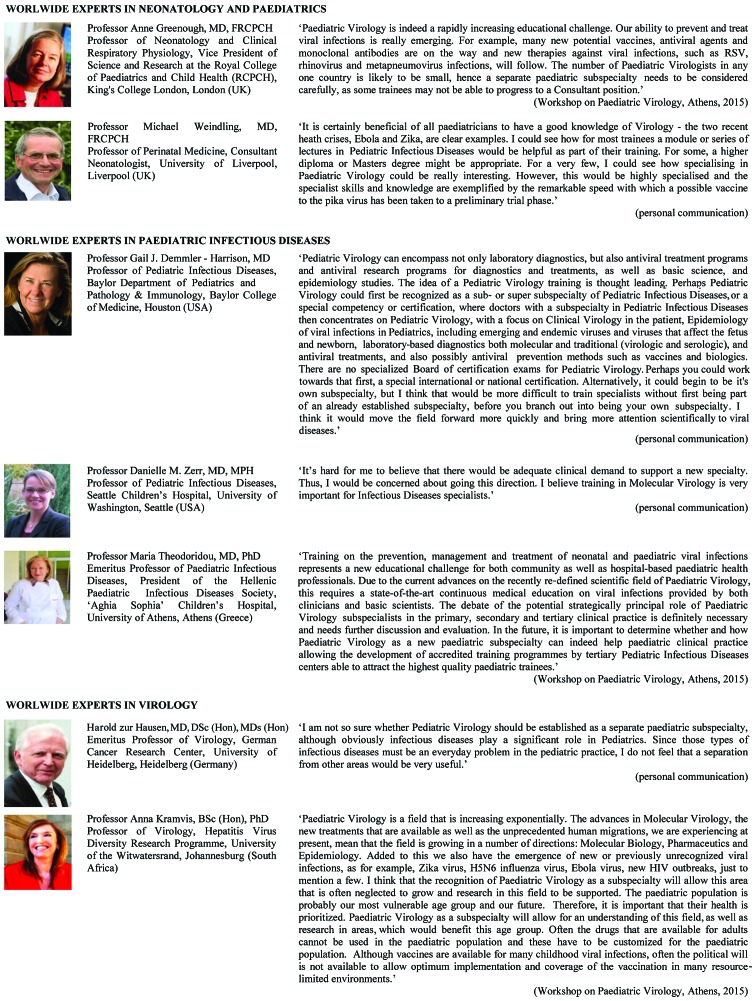Paediatrics [<παῖς (pais=child) + ‘ἰάομαι/ἰῶμαι’ (iaome/iome=healing)] is the science and the art of treating infants, children and adolescents, supporting their health, growth and development and ensuring their opportunity to achieve full potential in adulthood (1). As a stimulating, diverse and hugely rewarding medical specialty, it manages a wide range of medical conditions, diseases and disorders, which affect the paediatric population. For this reason, Paediatrics is a broad-based specialty, allowing paediatric health professionals to be either based in the community - evaluating, monitoring and coordinating paediatric patients and their parents - or to become subspecialised in certain areas of interest (2). Paediatric subspecialties, including Paediatric Infectious Diseases, constitute a modern trend in Paediatrics. The medical school settings, as well as the tertiary hospitals, have been specified as the main employment sites of paediatric subspecialists (3). Factors influencing subspecialty choice by paediatric trainees include what is valued by them and excessively vary in certain subspecialties (4).
Since our proposal on Saturday the 10th of October, 2015 (5), Paediatric Virology has attracted the critical interest of several worldwide experts in the scientific fields of Neonatology, Paediatrics, Paediatric Infectious Diseases and Virology (Fig. 1). These experts have been asked by members of the Paediatric Virology Study Group (PVSG) and have enthusiastically offered their valuable input on the debate of the potential role of Paediatric Virology as a new paediatric subspecialty. Although this debate has already tagged difficulties, challenges and limitations on this proposal, the potential value of Paediatric Virology subspecialists has undoubtedly been accepted. Nevertheless, our purpose is not to cause a destructive revolution on the existing educational platforms and training programmes on Paediatric Infectious Diseases (6), but to create and add a tiny ‘mosaic tile’ in future Paediatrics.
Figure 1.
Opinions by 7 worldwide experts on Neonatology, Paediatrics, Paediatric Infectious Diseases and Virology, on the debate ‘Paediatric Virology as a new paediatric subspecialty’, recorded by the Paediatric Virology Study Group (PVSG).
Mosaic [see Fig. 1 in Mammas and Spandidos (7)] is an artwork technique of creating images with tiny pieces of coloured tiles made of rock, wood, glass or other, usually colourful materials. The ancient Greek origin of mosaic, ‘ψηφιδωτό’ (psefidoto), comes from the ancient Greek noun ‘ψηφίς’ (psefis), meaning the tiny ‘mosaic tile’. Interestingly, the final picture in a mosaic is tried - and in most cases is achieved - to be superior to its ‘tile’ components. Similarly, the Paediatric Virology ‘tile’ should definitely aim to enhance and highlight the wonderful ‘mosaic’ of Paediatrics, enriching Paediatrics with newly acquired knowledge from Virology, Epidemiology, Molecular Medicine, Evidence-based Medicine, Clinical Governance, Quality Improvement, Pharmacology and Immunology (8). Our efforts have to be interpreted as an attempt to find the incentives to enhance and promote the workforce of this subspecialty. These incentives are what will be valued in the future by our little patients and their parents.
References
- 1.Stanton BF, Behrman RE. The field of Pediatrics. In: Kliegman RM, Behrman RE, Jenson HB, Stanton BF, editors. Nelson Textbook of Pediatrics. 18th. Saunders Elsevier; Philadelphia, PA: 2007. [Google Scholar]
- 2.http://www.rcpch.ac.uk/training-examinations-professional-development/paediatric-careers-and-recruitment/careers/what-paedi. [Feb 18;2016 ];Royal College of Paediatrics and Child Health (RCPCH): What is paediatrics? Accessed. [Google Scholar]
- 3.Stoddard JJ, Cull WL, Jewett EA, Brotherton SE, Mulvey HJ, Alden ER. AAP Committee on Pediatric Workforce Subcommittee on Subspecialty Workforce: Providing pediatric subspecialty care: A workforce analysis. Pediatrics. 2000;106:1325–1333. doi: 10.1542/peds.106.6.1325. [DOI] [PubMed] [Google Scholar]
- 4.Takeda Y, Morio K, Snell L, Otaki J, Takahashi M, Kai I. Characteristic profiles among students and junior doctors with specific career preferences. BMC Med Educ. 2013;13:125. doi: 10.1186/1472-6920-13-125. [DOI] [PMC free article] [PubMed] [Google Scholar]
- 5.Mammas IN, Greenough A, Theodoridou M, Spandidos DA. Paediatric Virology: A new paediatric subspecialty? A proposal at the Workshop on Paediatric Virology, Athens, October 10, 2015. Exp Ther Med. 2016;11:3–5. doi: 10.3892/etm.2015.2889. [DOI] [PMC free article] [PubMed] [Google Scholar]
- 6.http://www.espid.org/content.aspx?Group=education&Page=pid_training. [Sep 10;2003 ];European Society for Paediatric Infectious Diseases (ESPID): PID Training Programme (Syllabus) Accessed. [Google Scholar]
- 7.Mammas IN, Spandidos DA. Paediatric Virology in the Hippocratic Corpus. Exp Ther Med. doi: 10.3892/etm.2016.3420. (In press) [DOI] [PMC free article] [PubMed] [Google Scholar]
- 8.Mammas IN, Greenough A, Theodoridou M, Kramvis A, Christaki I, Koutsaftiki C, Koutsaki M, Portaliou DM, Kostagianni G, Panagopoulou P, et al. Current views and advances on Paediatric Virology: An update for paediatric trainees. Exp Ther Med. 2016;11:6–14. doi: 10.3892/etm.2015.2890. [DOI] [PMC free article] [PubMed] [Google Scholar]



